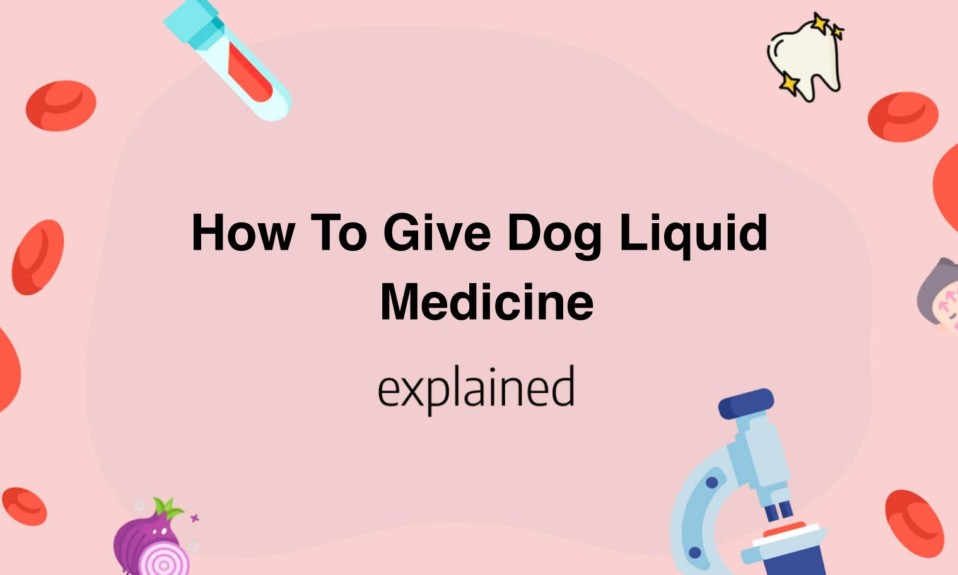Administering medication can be a challenge for pet owners, especially when it comes to dogs.
Knowing how to give dog liquid medicine can make the process easier and less stressful for both the pet and the pet parent.
This article will provide tips and techniques for safely and effectively giving liquid medication to dogs, including using the right tools, handling the dog properly, and making the medication more palatable.
- Gather necessary supplies such as medicine, syringe or dropper, and a treat for your dog.
- Use the syringe or dropper to measure the correct amount of liquid medicine.
- Hold your dog gently but firmly and tilt their head upwards.
- Slowly squirt the liquid into the side of their mouth, aiming towards the back of their throat.
- Give your dog a treat immediately after giving them the medicine to create a positive association.
Prepare the liquid medicine for your dog
To prepare liquid medicine for your dog, there are a few steps you must follow to ensure their safety and health.
First, consult with your veterinarian to determine the proper dosage and type of medication your dog needs.
Once you have this information, gather all necessary supplies, including a medicine dropper or syringe and the medication itself.
Next, measure the appropriate amount of medication using the dropper or syringe.
Be sure to double-check the dosage information and follow it precisely.
Hold your dog securely and open their mouth using your fingers or a specially designed pet pill dispenser.
Make sure your dog is calm and in a relaxed state before starting to administer the medication to avoid any accidents or injury.
Slowly and gently insert the dropper or syringe into the side of your dog’s mouth, pointing it towards the back of their throat.
Be careful not to insert it too far or the medication may accidentally enter their lungs, causing respiratory problems.
Squeeze the medicine into your dog’s mouth and give them a chance to swallow.
You can encourage swallowing by gently stroking their throat or blowing lightly on their nose.
Once the medication has been administered, give your dog a treat or some positive reinforcement to help them associate the experience with something positive.
Always closely monitor your dog following medication administration to make sure they don’t experience any adverse reactions.
Keep all medication out of reach of your dog to prevent accidental overdoses or consumption of harmful substances.
In conclusion, correctly preparing and administering liquid medication to your dog is essential for their health and well-being.
Follow these steps and always consult with your veterinarian if you have any questions or concerns.
With proper care and attention, your furry friend can continue to lead a happy and healthy life.
How To Give Dog Liquid Medicine
Liquid medicine can be tricky to administer to your pooch, but with a little patience and the right technique, it can be done without too much fuss.
Here’s how to give your dog liquid medicine in a gentle and effective way:
- Use a syringe or dropper to measure the correct dosage of the liquid medication prescribed by your vet.
- Position your dog so that they are standing or sitting in a comfortable position.
- Gently lift their head up and tilt it back slightly.
- Use your free hand to open their mouth by placing your thumb and fingers on either side of their jaw towards the back of their mouth.
- Use the medicine dropper or syringe to gently place the medication towards the back of their tongue and slowly dispense the liquid.
- Once the medication is in their mouth, hold their mouth closed and stroke their throat or blow gently on their nose to encourage them to swallow.
- If your dog resists, try mixing the medication with a small amount of wet food or a treat that they enjoy to make it more palatable.
- Be sure to give your dog plenty of praise and a reward for taking their medication to create a positive association. It’s important not to force your dog to take their medication, as this can cause them to become frightened and distressed.
If you are having difficulty administering their medication, try speaking to your veterinarian to see if there is an alternate form of medication or a better technique for administering the liquid.
By being patient and gentle, you can ensure that your furry friend stays healthy and gets the medication they need to feel better.
Gather the necessary equipment for administration
To properly administer a treatment or medication, it is important to have the necessary equipment on hand.
The specific equipment needed may vary depending on the type of treatment or medication being administered.
However, a few basic items are essential to have before beginning.
Firstly, it is important to have gloves and a mask to prevent the spread of germs or infection.
Wearing gloves and a mask also protects the healthcare worker from coming into contact with bodily fluids or other potentially harmful substances.
Secondly, a clean and suitable area for administration is necessary.
This could be a table or surface that has been disinfected with a germ-killing cleaner.
It is also important to ensure that all necessary equipment is within reach and organized in a manner that is easy to access.
Thirdly, needles and syringes are often essential for administering medication.
These should be stored in a safe and sterile location until they are needed.
It is important to ensure that the correct size and type of needle is selected for the specific treatment being administered.
Fourthly, a clean and disinfected container for used needles and other waste materials is essential.
This prevents the spread of infection and also ensures that any hazardous materials are disposed of in a safe and responsible manner.
Fifthly, appropriate medication or treatment should be available and ready to be administered.
It is important to ensure that the medication has not expired and that the correct dosage is measured before administering.
Lastly, it is important to have access to emergency equipment if needed, such as an epinephrine injector or defibrillator.
This could potentially save a patient’s life in the case of a severe allergic reaction or cardiac arrest.
By ensuring that all necessary equipment is available and organized, healthcare workers can focus on providing safe and effective treatments to their patients.
It is also important to regularly evaluate and update equipment as needed to ensure that it meets current health and safety standards.
Choose the best way to give your dog liquid medicine
Giving liquid medicine to your dog can be a stressful task, but it is important to help them recover from illnesses or injuries.
Here are some ways to make giving liquid medicine more manageable:
- Use a syringe or dropper: This method gives you the most control over the dosage and can help prevent spills and messes. Gently insert the syringe or dropper into the side of your dog’s mouth and slowly push the plunger to administer the medicine.
Be sure to reward your dog with praise or a treat afterwards.
- Hide it in food: If your dog is a picky eater, this method may work best. Mix the medicine with a small amount of wet food or a treat like peanut butter or cheese.
Make sure to check with your vet to ensure the medication can be given with food and that the ingredients in the food don’t cancel out the medicine’s effects.
- Mix it with a liquid: Some medications can be mixed in with a small amount of water or broth to make it more palatable for your dog. Always check with your vet before doing this to make sure the medication is still effective when diluted.
It’s important to note that you should never try to force the medicine down your dog’s throat or mix it with their water bowl as this can be dangerous and ineffective.
If your dog is still struggling with taking liquid medication, contact your vet for other options like pills or flavored chewables.
Remember to always praise and reward your dog for taking their medicine to make it a positive experience.
You’ll also like: Does Masturbation Actually Decrease Strength
Training your dog to accept liquid medicine
can be a challenging task, but with some patience and persistence, it is definitely possible to make the process smoother for both you and your furry friend.
Let’s start by understanding why dogs may be hesitant to take liquid medication.
The taste and texture of the medicine can be unpleasant for them, and they may associate it with negative experiences such as feeling sick or going to the vet.
To make the process easier, try the following tips:
- Use a syringe or dropper: This allows you to have more control over the amount of medicine dispensed and ensures your dog is getting the correct dosage. You can also aim the syringe towards the back of your dog’s mouth, which makes it harder for them to spit out the medicine.
- Mix the medicine with a tasty treat: This can make the medicine more appealing to your dog. However, make sure to check with your veterinarian if it is safe to mix the medication with food.
Some medications need to be taken on an empty stomach.
- Create a positive association: Try to pair the medicine with a positive experience such as a walk afterwards or a favorite toy. This can help your dog associate taking their medicine with something enjoyable.
- Be calm and patient: Dogs can sense our emotions and if you’re feeling impatient or stressed, they may become nervous or hesitant. Be gentle, calm, and give your pup lots of encouragement and positive reinforcement such as treats or praise.
It’s important to always consult with your veterinarian before giving any medication to your dog.
They can provide guidance on dosage, administration, and possible side effects.
By using the tips mentioned above and being patient, you can make giving liquid medication a stress-free experience for both you and your pup.
Read also: Foods to Avoid While Taking Miralax
Tips for making liquid medicine application easier
When it comes to taking liquid medicine, it can be a challenge for many people, especially young children or those who are struggling with some sort of physical ailment.
However, there are some tips that can make liquid medicine application easier and more comfortable.
- Use a syringe or dropper: One of the easiest ways to take liquid medicine is to use a syringe or dropper. This allows for more precise measurement of the dosage and can also make it easier for children or those with mobility issues to take the medicine.
- Mix it with a favorite beverage: If the taste of the liquid medicine is unpleasant, mix it with a favorite beverage like juice or soda to make it more palatable. However, be sure to check with a doctor or pharmacist first to make sure the medication can be taken this way.
- Chill the medicine: Some liquid medicines are better tolerated when they are cold. Place the medication in the refrigerator for a short time before taking it to make the taste more pleasant.
- Use a straw: For those who have difficulty swallowing, using a straw can help to make the process easier. This allows the medicine to bypass the tongue and go straight to the back of the throat, making swallowing easier.
- Follow the instructions: Always read the label and follow the instructions provided by the doctor or pharmacist. This ensures the medication is taken correctly and at the appropriate dosage.
By following these tips, liquid medicine application can be made easier and more comfortable for those who need it.
Remember, if you have any questions or concerns about taking medications, always consult with a healthcare professional.
Read also:










